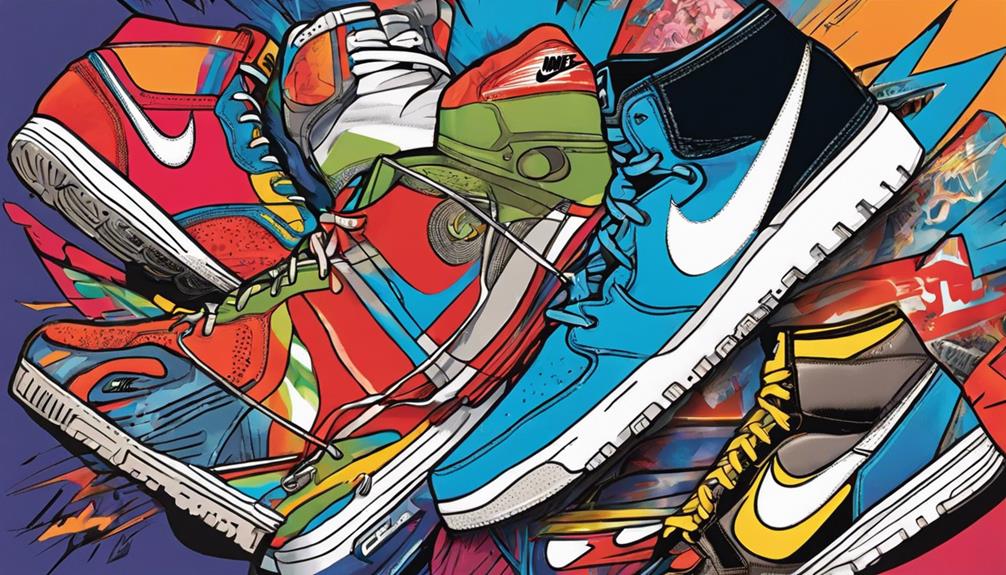Phil Knight took a simple $3,000 idea and turned it into Nike, a global leader in athletic footwear and apparel. Growing up in Portland, he combined his passion for running with innovative marketing tactics, like endorsing athletes instead of relying solely on ads. By launching Nike in 1972, he created a brand that resonated with consumers, skyrocketing sales from 10,000 pairs to over a million. Despite facing intense competition, Knight's focus on innovation and workplace culture helped Nike thrive. If you want to discover more about his journey and key strategies, keep exploring the fascinating story behind his success.
Key Takeaways
- Phil Knight's passion for running and innovative business strategies laid the foundation for Nike's success in the sports industry.
- The brand initially launched as Blue Ribbon Sports in 1972, later renamed Nike, named after the Greek goddess of victory.
- Knight's revolutionary marketing tactics included athlete endorsements, which created authentic connections and significantly boosted sales.
- Product innovations like Nike Air cushioning and Dri-FIT fabric positioned Nike as a leader in performance footwear and apparel.
Phil Knight's Early Life
Phil Knight grew up in Portland, Oregon, where his early passion for running laid the foundation for his future as a sports industry pioneer. You can imagine him as a dedicated athlete, often training on the local tracks, dreaming of greatness.
His love for the sport pushed him to compete at the collegiate level, and it was during this time that he began to envision a future in athletics. While pursuing his master's degree at Stanford, you'd see him developing a business plan that would change the sneaker market forever.
Selling shoes from his car at track meets, he recognized a gap in the market, setting the stage for what would eventually become Nike, a brand synonymous with sports excellence.
The Birth of Nike

In 1972, Knight's vision transformed from a simple business plan into the foundation of Nike, as he and Bill Bowerman officially launched the brand, initially known as Blue Ribbon Sports. They started selling shoes from Knight's car at track meets, quickly gaining traction in the Pacific Northwest. As sales grew, they realized a name change was essential, leading to the birth of Nike, inspired by the Greek goddess of victory.
| Year | Sales Growth |
|---|---|
| 1972 | $3,000 |
| 1975 | $1 million |
| 1980 | $10 million |
| 1986 | $1 billion |
This evolution marked the beginning of a revolutionary journey in the sports industry.
Revolutionary Marketing Tactics

Nike revolutionized marketing by prioritizing athlete endorsements over traditional advertising methods, creating an authentic connection with consumers.
You'd notice how endorsements from stars like Steve Prefontaine and John McEnroe transformed the brand. Instead of generic ads, Nike showcased real athletes, making their products synonymous with success and performance.
This strategy resonated deeply with fans and sparked a jogging culture that fueled demand for Nike shoes. As you observe, sales skyrocketed from 10,000 to over 1 million pairs, illustrating the power of personal connection in marketing.
Knight's innovative approach not only set Nike apart but also reshaped the entire sports industry, encouraging brands to invest in genuine relationships with their endorsers and audiences alike.
Overcoming Business Challenges

While innovative marketing strategies fueled growth, overcoming business challenges like intense competition and shifting consumer preferences became pivotal for sustained success.
You'll find that during the late 1980s, Nike faced an 18% sales drop, primarily due to competition from Reebok. To combat this, Knight and his team introduced the Nike Air line, which revitalized sales and regained market leadership by 1990.
Additionally, labor controversies and Jesse Jackson's boycott pressured Nike to diversify its leadership, ultimately strengthening the company's image. By focusing on employee engagement and adapting management strategies, you can see how Nike navigated these hurdles.
Each challenge reinforced Knight's vision and commitment to innovation, ensuring Nike remained a dominant force in the athletic footwear market.
Innovations in Product Development

Innovative product development has been essential for Nike's ability to stay ahead in a competitive market. You'll notice that Nike consistently pushes boundaries, introducing technologies that enhance performance and comfort. For example, the use of Nike Air cushioning revolutionized footwear, while Flyknit technology offered lightweight, form-fitting options.
Here's a snapshot of some key innovations:
| Innovation | Impact |
|---|---|
| Nike Air | Improved shock absorption and comfort |
| Flyknit | Enhanced breathability and flexibility |
| Dri-FIT | Moisture-wicking fabric for athletes |
These innovations not only boost athletic performance but also keep consumers coming back for more, solidifying Nike's position as a leader in the industry.
Workplace Culture and Employee Engagement

A strong workplace culture is essential for fostering employee engagement and driving overall success in any organization.
When you prioritize authentic communication, you create an environment where employees feel valued and heard. This leads to increased productivity and innovation.
By addressing workplace issues collectively, you cultivate a sense of responsibility and teamwork. Genuine investment in employee satisfaction pays off; it reduces turnover and enhances morale.
Recognizing achievements and encouraging collaboration can transform your workplace dynamics.
Nike exemplifies this by promoting a culture of creativity and inclusivity, which empowers employees to excel.
Ultimately, when you nurture a supportive atmosphere, you not only enhance employee engagement but also propel your organization toward long-term success.
Embrace these principles for a thriving workplace.
Lessons for Aspiring Entrepreneurs

Learning from Phil Knight's journey with Nike reveals essential lessons for aspiring entrepreneurs seeking to carve out their own paths in the business world. By understanding his experiences, you can navigate challenges and seize opportunities effectively.
Here are some key takeaways to guide you:
- Focus on market research to identify customer needs.
- Embrace iterative product development for agility and adaptability.
- Build strong relationships with key influencers and partners.
- Prioritize employee engagement to foster a positive work culture.
How Did Private Equity Impact the Vision of Phil Knight at Nike?
When private equity beauty brand transformation entered the scene at Nike, it significantly impacted Phil Knight’s vision. The injection of external capital allowed for expanded opportunities and resources, leading to a transformation in the brand’s strategy and market positioning. This partnership brought about innovative changes and propelled Nike’s growth trajectory.
Conclusion
Phil Knight's journey is a proof of the power of perseverance and innovation.
From selling shoes out of his car to creating a global powerhouse, he shows that success isn't a straight line but a winding road filled with lessons.
Embrace challenges, think creatively, and engage your team—these are keys to releasing your own potential.
As you carve your path, remember: every step, no matter how small, can lead to greatness.
Keep moving forward!









